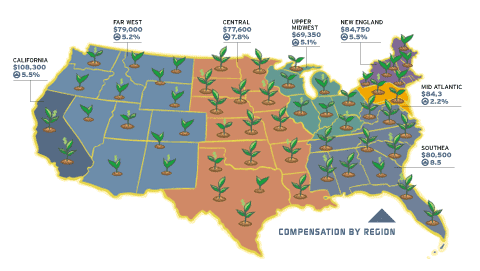South Is On The Rise

Published for the Week Of June 28, 2004

\
Solution providers in the southeastern United States handed out the largest raises last year, apparently becoming early beneficiaries of the still-spotty economic recovery.
In the southeastern United States, an area ranging from West Virginia in the North to the Mississippi River in the West, average compensation rose a strong 8.5 percent to $80,500, according to the 2004 CRN Salary Survey. This compared with an average 5.9 percent rise nationwide.
While average compensation in the region still lags behind the high-paying technology centers in California, New England and the mid-Atlantic, the Southeast is catching up. This is the second year in a row that the region experienced above-average raises.
The rising salaries in the Southeast also contrasted sharply with their neighbors to the north. The mid-Atlantic states, including New Jersey, Pennsylvania, Delaware, Maryland and Washington, D.C., experienced the slowest compensation growth of any region. Compensation rose just 2.2 percent to $84,300 last year.
“From our perspective, raises were slim last year and will probably be slim this year,” said Pete Busam, vice president and COO of Decisive Business Systems, a solution provider in Pennsauken, N.J., that employs 25 people.
| AD | |
|---|---|
| id | unit-1659132512259 |
| type | Sponsored post |
He attributed that partly to the region’s stable work force and high wages earned in years past. Many of his employees have been with the company seven to 10 years. “During the great years, they achieved some very nice salary increases and now they’ve maxed out,” he said.
The country’s midsection was also catching up with the higher-salary regions. Salaries in the central United States rose 7.8 percent to an average $77,600. That broad region, as defined by the survey, includes Texas, Arkansas, Louisiana, Oklahoma, Missouri, Kansas, Iowa, Minnesota, Nebraska and North and South Dakota.
While Houston-based Wright Business Technologies was not feeling any pressure to raise salaries and still finds employees plentiful, the company boosted average compensation in the 5 percent range last year. Why? “Because we could afford it,” said Jennifer Wright, company vice president. “That’s the main reason. In the past few years, we haven’t been able to afford it.”
She said the company’s growing managed service business helped provide the company with a stable, recurring revenue stream. “Managed services have been around for a while,” she said. “This year all the stars are aligning. The technology is ready, the customers are ready for this type of model in the small- to medium-size-business market.”
The recovery also appeared to be boosting wages in California, despite the fact that average compensation there was already the highest in the nation at $108,300. California solution providers boosted compensation about 5.5 percent, according to the survey.
One such solution provider was Network Solutions, Tustin, Calif. Strong growth in the company’s managed service business, along with renewed product sales growth, enabled the company in 2003 to hire on many of the contract workers it had been using full time.
“In the downturn, we went from an all-employee model to a contract model,” said company CEO Robert Whiton. “And then we had a really good year last year and we went to all employees because we could do it at a beneficial labor cost.”
Solution providers in the Far West, Upper Midwest and New England also were able to increase compensation near the national average.
The Upper Midwest boasted the lowest average compensation, though, at $69,350. Laurie Benson, CEO of Inacom Information Systems, Madison, Wis., said top employees earn the same as counterparts elsewhere, but middle-level employees may earn less because the cost of living is lower.